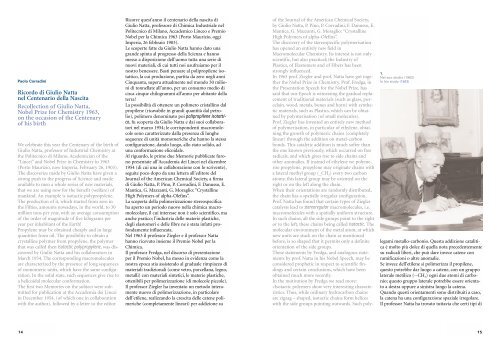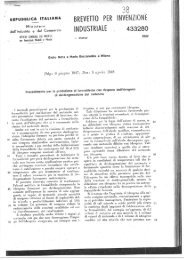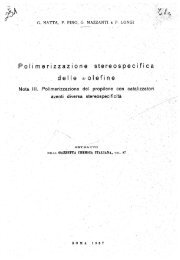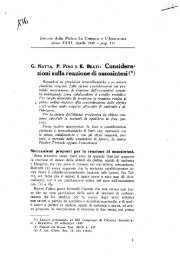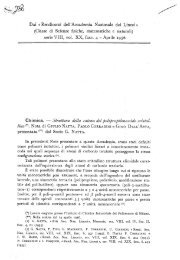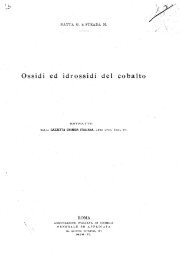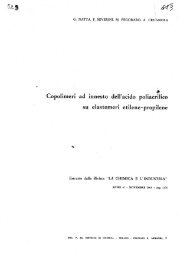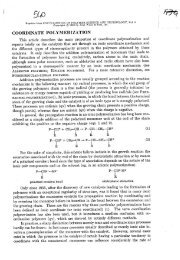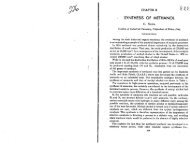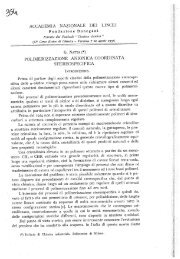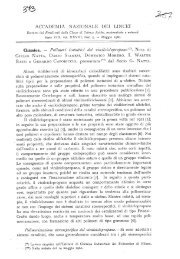n. 7, Ottobre 2003 - Giulio Natta
n. 7, Ottobre 2003 - Giulio Natta
n. 7, Ottobre 2003 - Giulio Natta
You also want an ePaper? Increase the reach of your titles
YUMPU automatically turns print PDFs into web optimized ePapers that Google loves.
Paolo Corradini<br />
Ricordo di <strong>Giulio</strong> <strong>Natta</strong><br />
nel Centenario della Nascita<br />
Recollection of <strong>Giulio</strong> <strong>Natta</strong>,<br />
Nobel Prize for Chemistry 1963,<br />
on the occasion of the Centenary<br />
of his birth<br />
We celebrate this year the Centenary of the birth of<br />
<strong>Giulio</strong> <strong>Natta</strong>, professor of Industrial Chemistry at<br />
the Politecnico di Milano, Academician of the<br />
“Lincei” and Nobel Prize in Chemistry in 1963<br />
(Porto Maurizio, now Imperia, February 26, 1903).<br />
The discoveries made by <strong>Giulio</strong> <strong>Natta</strong> have given a<br />
strong push to the progress of Science and made<br />
available to men a whole series of new materials,<br />
that we are using now for the benefit (welfare) of<br />
mankind. An example is isotactic polypropylene.<br />
The production of it, which started from zero in<br />
the Fifties, amounts nowadays, in the world, to 30<br />
million tons per year, with an average consumption<br />
of the order of magnitude of five kilograms per<br />
year per inhabitant of the Earth!<br />
Propylene may be obtained cheaply and in large<br />
quantities from oil. The possibility to obtain a<br />
crystalline polymer from propylene, the polymer<br />
that was called then isotactic polypropylene, was discovered<br />
by <strong>Giulio</strong> <strong>Natta</strong> and his collaborators in<br />
March 1954. The corresponding macromolecules<br />
are characterized by the presence of long sequences<br />
of monomeric units, which have the same configuration.<br />
In the solid state, such sequences give rise to<br />
a helicoidal molecular conformation.<br />
The first two Memories on the subject were submitted<br />
for publication at the Accademia dei Lincei<br />
in December 1954. (of which one in collaboration<br />
with the author), followed by a letter to the editor<br />
Ricorre quest’anno il centenario della nascita di<br />
<strong>Giulio</strong> <strong>Natta</strong>, professore di Chimica Industriale nel<br />
Politecnico di Milano, Accademico Linceo e Premio<br />
Nobel per la Chimica 1963 (Porto Maurizio, oggi<br />
Imperia, 26 febbraio 1903).<br />
Le scoperte fatte da <strong>Giulio</strong> <strong>Natta</strong> hanno dato una<br />
grande spinta al progresso della Scienza e hanno<br />
messo a disposizione dell’uomo tutta una serie di<br />
nuovi materiali, di cui tutti noi usufruiamo per il<br />
nostro benessere. Basti pensare al polipropilene isotattico,<br />
la cui produzione, partita da zero negli anni<br />
Cinquanta, supera attualmente nel mondo 30 milioni<br />
di tonnellate all’anno, per un consumo medio di<br />
circa cinque chilogrammi all’anno per abitante della<br />
terra!<br />
La possibilità di ottenere un polimero cristallino dal<br />
propilene (ricavabile in grandi quantità dal petrolio),<br />
polimero denominato poi polipropilene isotattico,<br />
fu scoperta da <strong>Giulio</strong> <strong>Natta</strong> e dai suoi collaboratori<br />
nel marzo 1954; le corrispondenti macromolecole<br />
sono caratterizzate dalla presenza di lunghe<br />
sequenze di unità monomeriche che hanno la stessa<br />
configurazione, dando luogo, allo stato solido, ad<br />
una conformazione elicoidale.<br />
Al riguardo, le prime due Memorie pubblicate furono<br />
presentate all’Accademia dei Lincei nel dicembre<br />
1954 (di cui una in collaborazione con lo scrivente),<br />
seguite poco dopo da una lettera all’editore del<br />
Journal of the American Chemical Society, a firma<br />
di <strong>Giulio</strong> <strong>Natta</strong>, P. Pino, P. Corradini, F. Danusso, E.<br />
Mantica, G. Mazzanti, G. Moraglio: “Crystalline<br />
High Polymers of alpha-Olefins”.<br />
La scoperta della polimerizzazione stereospecifica<br />
ha aperto un periodo nuovo nella chimica macromolecolare,<br />
il cui interesse non è solo scientifico, ma<br />
anche pratico; l’industria delle materie plastiche,<br />
degli elastomeri e delle fibre ne è stata infatti profondamente<br />
influenzata.<br />
Nel 1963 il professor Ziegler e il professor <strong>Natta</strong><br />
hanno ricevuto insieme il Premio Nobel per la<br />
Chimica.<br />
Il professor Fredga, nel discorso di presentazione<br />
per il Premio Nobel, ha messo in evidenza come la<br />
nostra epoca stia assistendo al graduale rimpiazzo di<br />
materiali tradizionali (come vetro, porcellana, legno,<br />
metalli) con materiali sintetici, le materie plastiche,<br />
ottenibili per polimerizzazione (di molecole piccole).<br />
Il professor Ziegler ha inventato un metodo interamente<br />
nuovo di polimerizzazione, in particolare<br />
dell’etilene, realizzando la crescita delle catene polimeriche<br />
(completamente lineari) per addizione su<br />
of the Journal of the American Chemical Society,<br />
by <strong>Giulio</strong> <strong>Natta</strong>, P. Pino, P. Corradini, F. Danusso, E.<br />
Mantica, G. Mazzanti, G. Moraglio: “Crystalline<br />
High Polymers of alpha-Olefins”.<br />
The discovery of the stereospecific polymerisation<br />
has opened an entirely new field in<br />
Macromolecular Chemistry. Its interest is not only<br />
scientific, but also practical; the Industry of<br />
Plastics, of Elastomers and of Fibers has been<br />
strongly influenced.<br />
In 1963 prof. Ziegler and prof. <strong>Natta</strong> have got together<br />
the Nobel Prize in Chemistry. Prof. Fredga, in<br />
the Presentation Speech for the Nobel Prize, has<br />
said that our Epoch is witnessing the gradual replacement<br />
of traditional materials (such as glass, porcelain,<br />
wood, metals, bones and horn) with synthetic<br />
materials, such as Plastics, which can be obtained<br />
by polymerisation (of small molecules).<br />
Prof. Ziegler has invented an entirely new method<br />
of polymerisation, in particular of ethylene, obtaining<br />
the growth of polymeric chains (completely<br />
linear) through the addition on metal-carbon<br />
bonds. This catalytic addition is much softer than<br />
the one known previously, which occurred on free<br />
radicals, and which gives rise to side chains and<br />
other anomalies. If instead of ethylene we polymerise<br />
propylene, propylene may originate chains with<br />
a lateral methyl group (_CH 3 ) every two carbon<br />
atoms; this lateral group may be oriented on the<br />
right or on the left along the chain.<br />
When their orientations are randomly distributed,<br />
the chain has a spatially irregular configuration.<br />
Prof. <strong>Natta</strong> has found that certain types of Ziegler<br />
catalysts lead to stereoregular macromolecules, i.e.<br />
macromolecules with a spatially uniform structure.<br />
In such chains, all the side groups point to the right<br />
or to the left, these chains being called isotactic.The<br />
molecular environment of the metal atom, at which<br />
new units are stuck on the chain as mentioned<br />
before, is so shaped that it permits only a definite<br />
orientation of the side groups.<br />
These statements by Fredga, and analogous statements<br />
by prof. <strong>Natta</strong> in his Nobel Speech, may be<br />
considered prophetic in respect to scientific findings<br />
and certain conclusions, which have been<br />
obtained much more recently.<br />
In the motivation by Fredga we read more:<br />
«Isotactic polymers show very interesting characteristics.<br />
Thus, while ordinary hydrocarbon chains<br />
are zigzag – shaped, isotactic chains form helices<br />
with the side groups pointing outwards. Such poly-<br />
1.<br />
Nel suo studio (1963)<br />
In his study (1963)<br />
legami metallo-carbonio. Questa addizione catalitica<br />
è molto più dolce di quella nota precedentemente<br />
su radicali liberi, che può dare invece catene con<br />
ramificazioni o altre anomalie.<br />
Se invece dell’etilene si polimerizza il propilene,<br />
questo potrebbe dar luogo a catene, con un gruppo<br />
laterale metilico (--CH 3 ) ogni due atomi di carbonio;<br />
questo gruppo laterale potrebbe essere orientato<br />
a destra oppure a sinistra lungo la catena.<br />
Quando questi orientamenti sono distribuiti a caso,<br />
la catena ha una configurazione spaziale irregolare.<br />
Il professor <strong>Natta</strong> ha trovato tuttavia che certi tipi di<br />
14<br />
15


